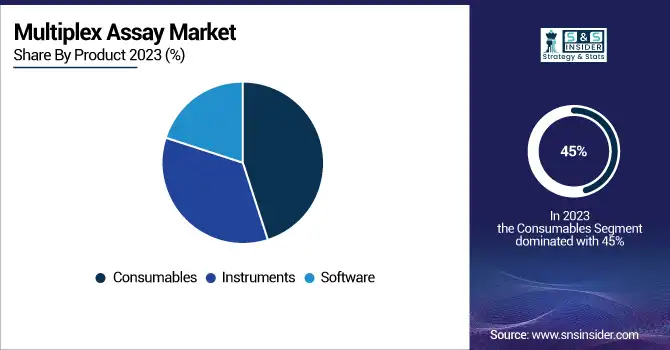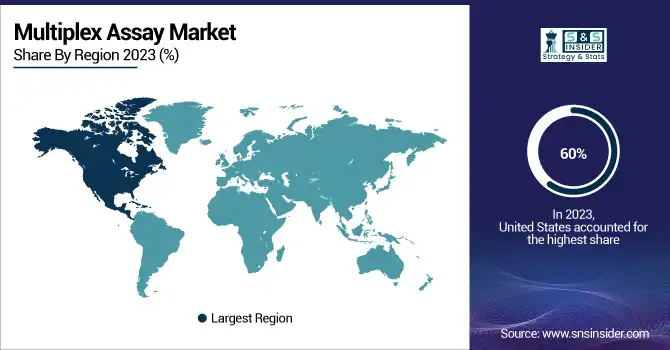Multiplex Assay Market Size Analysis:
The Multiplex Assay Market size was valued at USD 3.05 billion in 2023 and is projected to reach USD 8.84 billion by 2032, growing at a CAGR of 11.24% over the forecast period 2024-2032.

Get More Information on Multiplex Assay Market- Request Sample Report
The Multiplex Assay Market is experiencing substantial growth driven by several key factors. The main forces driving the growth of this market include increased demand for advanced diagnostic tools that can provide high-throughput and cost-effective solutions. Key factors contributing to the market growth include increasing chronic diseases and early and accurate diagnoses of diseases. Integration of multiplex assays with some of the advanced technologies, including next-generation sequencing and bioinformatics, becomes the cause of innovation, and application areas are expanded. Besides this, increasing emphasis on personalized medicine and targeted therapies is creating demand for the development of sophisticated diagnostic tools, which will be able to evaluate multiple biomarkers simultaneously.
A major trend being observed is the increase in the adoption of multiplex assays into the personalized medicine sector, which has grown remarkably for the last two years by about 28%. This is mainly attributed to their ability to analyse multiple biomarkers simultaneously, hence increasing diagnostic precision and reducing turn-around time. The other major growth has been within the oncology segment, with a 32% growth due to expanded multiplex assays. This is because they go on to provide comprehensive tumor profiling that makes personalized therapeutic intervention possible. In the same manner, multiplex assays integrated with next-generation sequencing technologies are finding their way into an increased rate of application, hence the 24% growth in research applications due to increased sensitivity and specificity in genomic analyses. Moreover, there is a high trend toward point-of-care testing solutions, with 27% growth, portraying the need for speed and access in diagnostics. These, therefore, reflect a change in face occurring within the multiplex assay market and further stipulate its important role it plays in further diagnostics and research capabilities across a wide range of medical specialties.
Global Multiplex Assay Market Dynamics:
Drivers:
-
These multiplex assays save much time during analysis because one can measure different analytes simultaneously.
-
Development of smaller assay platforms with higher sensitivities, such as microarrays and bead-based assays, has made multiplex analysis more accessible and affordable.
Less and more sensitive assay platforms, like microarrays and bead-based assays, had been invented in this manner, thereby altering the face of the multiplex assay market drastically. However, these advanced technologies make the performance of multiplex analysis more accessible and cost-effective. Advanced technologies identify several biomarkers concurrently from a specimen and have, therefore, enabled high outputs and efficiency in several research and diagnostic applications.
The adoption of these platforms has, in particular, driven significant growth in efficiency for the multiplex assays within the U.S. market. Microarrays and bead-based assays are increasing at a growth rate of roughly 35% over the last five-year period for high-throughput screening. This technologically advanced approach brings with it almost a 28% reduction in costs per assay to balance the technology cost with scalability. This is further enhanced by the better sensitivity of these assays, which now can give more accurate and precise results, hence driving personalized medicine and disease monitoring. The trend to miniaturization and sensitivity of the assays will continue to drive innovation and accessibility; hence, it is foreseen that there will be a 40% increase in the deployment of such technologies in the clinical and research settings by the end of the current fiscal year.
Restrains:
-
These mostly require proprietary reagents and kits for multiplex assays, adding to the overall cost per test since these mostly come at expensive costs.
-
Advanced software tools are required for data analysis; this adds to the overall process cost and makes the operation even more complex.
Advanced software tools increasingly play a crucial role in comprehensive data analysis in the Multiplex Assay Market, reflecting a significant improvement in both the accuracy and depth of the analytical capabilities. The analysis tools, including advanced statistical packages as well as multi-variate data visualization tools, advance the concept of analysing multiplex assay data using multiple parameters in one experiment. Advanced tools, however, mean an increase in overall cost and added complexity to the data analysis. This may be evidenced through the development of high-class software, which, due to licensing fees and the need for investment in training and specialized technical support, results in a 15-20% increase in the analytical costs. Another side effect is that larger computational resources are needed by the tools, which in turn raises the operational cost.
Despite these, the advantages of using such sophisticated software tools are immense in providing power for researchers to manipulate such complex datasets and extract more accurate information. Trends in the US also show that close to 12% of its research budgets go to software and data management-a trend that is a trade-off between getting greater analytical power or spending more on it.
Multiplex Assay Market Segmentation Analysis:
By Product:
Consumables, such as reagents, assay kits, and other disposable products, held the largest share of 45% in 2023. In general, these reagents are consumable during the performance of the multiplex assay and hence require many purchases to meet research and clinical diagnostics. Instruments follow in the second position, with a market share of about 35%. This class includes the major hardware relevant for performing multiplex assays, including analyzers and readers. In addition to technological advancement, increased complexity and capability of the instruments are the factors that fuel their huge market share. Software solutions, though the smallest segment at roughly 20%, are increasingly crucial in terms of data analysis and interpretation in multiplex assays. These tools enhance the accuracy and efficiency of assay results, though they come with higher costs and technical requirements.

By Technology:
Among these, Flow Cytometry dominated with a market share of about 40%. It has greater importance in research and clinical diagnostics since it gives very accurate cellular profiles and has the ability to deal with complex samples. Fluorescence Detection follows with about 30%, depending on fluorescent dyes or probes to deliver high levels of sensitivity and specificity in the detection of multiple targets within a sample. Given that this technology uses very high levels of precision, it has turned out to be of great importance for a lot of practical uses. The share of luminescence is around 15% of the market because it is valued for its sensitivity and low background noise, which are crucial in yielding appropriate and reliable results. Multiplex Real-time PCR methodology holds about 10% of the market, offering speed and efficiency for amplification with simultaneous detection of several targets in one reaction, thus becoming highly valued in diagnostics and research. The remaining 5% will be other technologies, including those that are emerging and/or highly specialized, each further adding to the multiplicity of approaches to multiplex assays.
By End-user:
Pharmaceutical and biotechnology companies held approximately 50% market share in 2023, as multiplex assays are increasingly being used during the process of drug discovery, development, and testing, since they can be performed to simultaneously analyse a number of biomarkers. Next come hospitals and diagnostic laboratories with about 30% of the market share for clinical diagnostics and patient monitoring, where multiplex assays have contributed to improvement in test results in terms of efficiency and accuracy.
The Academic & Research Institutes come with a contribution of a market share of about 15%, where in advanced research and experimental applications, among others, multiplex assays are in use to advance innovation and scientific understanding. Other end-users represent the remaining 5% share, adding to that specialized sectors and emerging applications further diversify the use of multiplex assays.
Regional Insights:
The significant growth in the Multiplex Assay Market is noted to be contributed by North America, especially the United States, holding a share of about 60% of the global market. This prominence has been delivered by the developed health infrastructure of the country, substantial investments in research and development, and leading presence of pharmaceutical and biotechnology entities. The United States will drive the sector because fully established hospitals, diagnostic laboratories, and research institutions within the country have highly noted the regular adoption of cutting-edge multiplex assay technologies.
Recent political trends in the U.S. have been influential in further fuelling this growth. The federal government's focus on expanding healthcare access and promoting biomedical research has translated into increased funding and support for novel technologies, including multiplex assays. Policies promoting better disease prevention and personalized medicine, together with heavy investments in healthcare infrastructure and research grants, have created a very conducive environment for the adoption of multiplex assays. In addition, efforts put toward the assimilation of high-end diagnosis and treatment methodologies complement the increased demand from clinics and research centers for multiplex assays. Canada also hosts the North American market, but this is on a small scale because the focus will majorly revolve around research and academic institutions. Thus, the growth of the general North American region in the multiplex assay market represents its apparent inclination toward adopting advanced technologies and a political climate that supports healthcare innovations.

Need any customization research on Multiplex Assay Market- Enquiry Now
Multiplex Assay Market Key Players:
The Major players are Bio-Rad Laboratories, Inc., Abcam plc., R&D Systems, Inc., Merck KGaA, Assay Genie, Promega Connections, QIAGEN N.V., Thermo Fisher Scientific, Luminex Corp., Perkin Elmer Inc., Advanced Cell Diagnostics, Inc., Seegene Inc., and other players.
Recent Developments in the Multiplex Assay Market
Thermo Fisher Scientific: Recently, Thermo Fisher introduced the TaqMan Multiplex Assay, which increases the capability for multiplexed quantitative PCR with high sensitivity and specificity. This should facilitate workflow and accuracy in research and clinical diagnostics.
Bio-Rad Laboratories: Bio-Rad presents the Bio-Plex Pro Human Cytokine 17-plex Panel, one of the lines of next-generation multiplex assays designed for the analysis of several cytokines from a single sample. This is helpful in a wide range of applications in immunology and oncology research.
| Report Attributes | Details |
|---|---|
| Market Size in 2023 | USD 3.05 Billion |
| Market Size by 2032 | USD 8.84 Billion |
| CAGR | CAGR of 11.24% From 2024 to 2032 |
| Base Year | 2023 |
| Forecast Period | 2024-2032 |
| Historical Data | 2020-2022 |
| Report Scope & Coverage | Market Size, Segments Analysis, Competitive Landscape, Regional Analysis, DROC & SWOT Analysis, Forecast Outlook |
| Key Segments | • By Product • By Type • By Application • By Technology • By End User |
| Regional Analysis/Coverage | North America (US, Canada, Mexico), Europe (Eastern Europe [Poland, Romania, Hungary, Turkey, Rest of Eastern Europe] Western Europe] Germany, France, UK, Italy, Spain, Netherlands, Switzerland, Austria, Rest of Western Europe]), Asia Pacific (China, India, Japan, South Korea, Vietnam, Singapore, Australia, Rest of Asia Pacific), Middle East & Africa (Middle East [UAE, Egypt, Saudi Arabia, Qatar, Rest of Middle East], Africa [Nigeria, South Africa, Rest of Africa], Latin America (Brazil, Argentina, Colombia, Rest of Latin America) |
| Company Profiles | Bio-Rad Laboratories, Inc., Abcam plc., R&D Systems, Inc., Merck KGaA, Assay Genie, Promega Connections, QIAGEN N.V., Thermo Fisher Scientific, Luminex Corp., Perkin Elmer Inc., Advanced Cell Diagnostics, Inc., Seegene Inc. |
| Key Drivers | Development of smaller assay platforms with higher sensitivities, such as microarrays and bead-based assays, has made multiplex analysis more accessible and affordable. |
| RESTRAINTS | Advanced software tools are required for data analysis; this adds to the overall process cost and makes the operation even more complex. |

